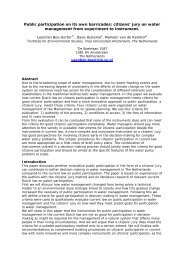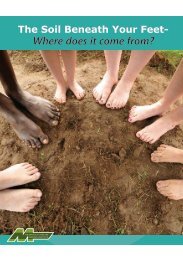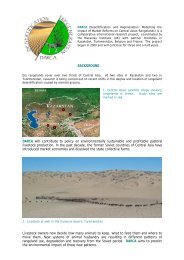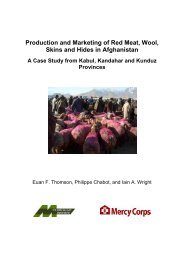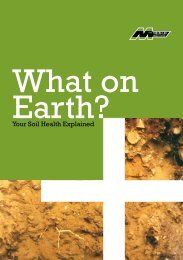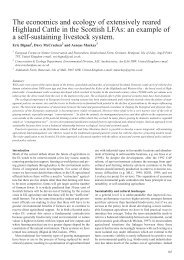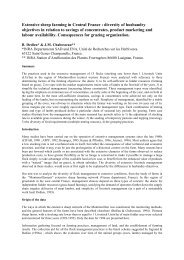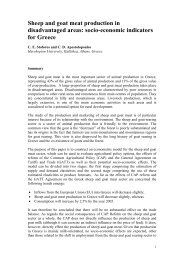Filature de Chantemerle - The Macaulay Land Use Research Institute
Filature de Chantemerle - The Macaulay Land Use Research Institute
Filature de Chantemerle - The Macaulay Land Use Research Institute
- No tags were found...
Create successful ePaper yourself
Turn your PDF publications into a flip-book with our unique Google optimized e-Paper software.
FILATURE European Fine DE CHANTEMERLE: Fibre Network, TEXTILE<br />
PRODUCTION Occasional Publication AND MARKETING No. 5 (1996) IN THE LONGO MAÏ 25 25<br />
<strong>Filature</strong> <strong>de</strong> <strong>Chantemerle</strong>: textile production<br />
and marketing in the Longo Maï cooperative<br />
Marie-Thérèse Chaupin & Joëlle Meunier,<br />
ATELIER, France<br />
In 1973, right at the beginning of the economical crisis, young people from different<br />
European countries began to create agricultural cooperatives as autonomous<br />
bases of survival in regions that were consi<strong>de</strong>red non-viable by the mo<strong>de</strong>rn<br />
economy. Since then, eight Longo maï cooperatives have been set up in Austria,<br />
France, Germany and Switzerland.<br />
One of the first priorities for the co-operative members was to feed and clothe<br />
themselves. From the start, they saw sheep as the best way of working poor land<br />
suitable for extensive livestock farming in <strong>de</strong>populated regions. <strong>The</strong> shepperd’s<br />
craft was learnt on the spot, thanks to neighbouring sheepfarmers.<br />
To make the most out of the wool, the problem of processing had to be tackled.<br />
You could then find many small closed down spinning factories along the mountain<br />
streams. In 1976, we found a spinning mill with all its machinery intact and the<br />
owner ready to pass on his know-how.<br />
To reopen a small processing unit in those days of industrial concentration and<br />
rationalisation seemed to many to be sheer utopia. But we had, from the start opted<br />
for an alternative form of production: a high level of quality for the raw material, a<br />
wi<strong>de</strong> range of products, direct contacts between bree<strong>de</strong>rs, the spinning mill and<br />
customers and to make it short, complete command of the production chain, from<br />
a to z.<br />
Gradually, machines more efficient even though they were bought second hand<br />
replaced the old ones. <strong>The</strong> factory consists of scouring, carding and spinning units,<br />
weaving and knitting machines, a clothes making workshop and a shop. It is<br />
powered by a turbine driven by the river. This autonomy is an essential element in<br />
the economy of our enterprise. Its also a practical alternative to the french all<br />
nuclear policy.<br />
Today the mill is operated by about eight members of the Longo maï co-operative.<br />
<strong>The</strong> rhythm of production is flexible according to the seasons. In addition to the<br />
wool of our own flocks, we also process fleeces <strong>de</strong>livered by about 50 bree<strong>de</strong>rs,
26 MARIE-THÉRÈSE CHAUPIN & JOËLLE MEUNIER<br />
i. e approximately 15 tonne of raw wool, 1 tonne of mohair and 300 kg of angora.<br />
We mentioned earlier the <strong>de</strong>liberate choice of an alternative form of production.<br />
This already starts with the purchase of the raw material. It is sorted and gra<strong>de</strong>d<br />
on arrival at the mill, with the bree<strong>de</strong>r whenever possible who is then paid on a<br />
quality basis (6 to 15 f per kilo of wool). Its a very good opportunity for advising<br />
bree<strong>de</strong>rs as to improvements in the selection, flock management, conditioning and<br />
storage areas.<br />
Another of our choices is that of subcontracting for bree<strong>de</strong>rs. We help them to<br />
choose the finished products best adapted to their wool <strong>de</strong>pending on its colour,<br />
length, thickness and fluffiness. <strong>The</strong>y will then market them on their farms. <strong>The</strong><br />
flexibility of our machines capacity enables us to process relatively small batches<br />
- with a minimum of 100 kg of raw wool. For example this year, the bree<strong>de</strong>rs of<br />
Solognote sheep, a rare breed with beige coloured wool got together to bring us<br />
their total annual clip which amounts to 800 kgs. We are at present processing it<br />
into socks, jumpers and cloth. Such small quantities of an unusual wool of this kind<br />
would never have found a purchaser. In this way it’s value has been greatly<br />
increased. By the way, in this assembly there are bree<strong>de</strong>rs who work together with<br />
our spinning mill. <strong>The</strong> payment for subcontracting work is often ma<strong>de</strong> in kind: i. e<br />
raw material which is then used for our own products.<br />
We also mentioned the importance of a wi<strong>de</strong> range of products. <strong>The</strong>se inclu<strong>de</strong><br />
knitting wool, cloth, blankets, socks, woolly hats, scarves, shirts and jumpers. We<br />
have also created several mo<strong>de</strong>ls of capes, jackets and waist-coats. All these<br />
products are 100% pure wool, have the natural colour of the sheep, ranging from<br />
off-white to dark brown and all the sha<strong>de</strong>s of beige and grey. <strong>The</strong> one exception<br />
being our line of silkscreen printed shawls and scarves.<br />
As far as marketing is concerned the key word is direct selling. In each of our Longo<br />
maï cooperatives, including the spinning mill, we have on sight shops for all our<br />
products. We also have regular stalls on the local markets and we take part in fairs<br />
and agricultural shows in France, Italy, Germany and Switzerland where a small<br />
mail or<strong>de</strong>r catalogue is available. Recently we have started approaching fashion<br />
<strong>de</strong>signers and interior <strong>de</strong>corators to find new outlets for our cloth.<br />
Yet another important point for us, training. And our own training to start with.<br />
We’ve learned progressively with experts in the fields of breeding, sheering, sorting<br />
and grading as well as in the various processing techniques. All these skills need<br />
competence and we are of course specialised. But we put a special emphasis on
FILATURE DE CHANTEMERLE: TEXTILE<br />
PRODUCTION AND MARKETING IN THE LONGO MAÏ<br />
27<br />
the fact that each one of us should be able to work in the different areas, if only to<br />
lend a hand when nee<strong>de</strong>d. It is a good way to un<strong>de</strong>rstand the notion of a production<br />
chain in its most basic form: you soon realise the consequences of your acts on the<br />
rest of the process. This experience which we have gained from others, we are now<br />
able to pass it on to others so that they also may profit from it. This means bree<strong>de</strong>rs<br />
and craftsmen but also, and this is a recent <strong>de</strong>velopment due to the economic crisis,<br />
to groups and associations which are consi<strong>de</strong>ring working with wool as a<br />
supplementary income.<br />
Over the years, all these contacts with the various actors of the wool production<br />
chain led us to launch in 1989 the European Association for Exchanges, Liaison<br />
Innovation and <strong>Research</strong> into Textiles, ATELIER for short. Its members are sheep<br />
goats rabbits and alpaca bree<strong>de</strong>rs, shearers, manufacturers, artists or scientists.<br />
What they have in common the will to cooperate on a solidarity basis to enhance<br />
the value of the raw material in or<strong>de</strong>r to give it back its place as an important factor<br />
of rural <strong>de</strong>velopment in so called rural areas in difficulty.<br />
<strong>The</strong> association was born in France but it has since spread to other European<br />
countries. A chart has been written which sets down the common objectives. Each<br />
of the members un<strong>de</strong>rtakes to use only local raw material the origin of which he can<br />
guarantee, to progress towards the complete command of the production chain,<br />
to be part of an exchange and solidarity network and to promote the products by<br />
using a quality label. No individual taking part in the processing of an ATELIER<br />
product must be subjected to any exploitation whatsoever.<br />
<strong>The</strong> members of ATELIER take part in fairs, shows and exhibition together, they<br />
have negotiated a collective licence contract with the Woolmark. <strong>The</strong>y also offer<br />
training courses for members and non-members. A questionnaire available in 8<br />
languages has been sent to 700 people in 14 countries. It’s aim is to get a picture<br />
of the situation in Europe and to draw up a series of propositions which will be<br />
submitted to authorities at regional, national and european levels.<br />
For two years now the ATELIER has ma<strong>de</strong> many contacts within the european<br />
institutions in or<strong>de</strong>r to make known the difficulties met by the wool sector. <strong>The</strong>re<br />
is no specific aid program for this sector as there is for other agricultural products.<br />
Why not, when the treaty of Rome was drawn up, wool was not mentioned as an<br />
agricultural product as flax and cotton were. As soon as wool leaves the back of<br />
the sheep, it becomes an industrial product.<br />
In the spring of 1994, the ATELIER was contacted by the Agenzia Lana d’Italia<br />
as the only french partner interested in wool in the sheep sector. <strong>The</strong> aim being to
28 MARIE-THÉRÈSE CHAUPIN & JOËLLE MEUNIER<br />
put forward proposals for the reform the the treaty of Rome. It was not a question<br />
of production subsidies for a new agricultural sector, but of receiving assistance for<br />
research, training, the setting up of structures for the collection and grading of wool,<br />
the processing of wool within the region of production, the promotion of quality<br />
products bearing a specific label.<br />
This initiative has already obtained the support of the British Wool marketing<br />
Board, the Spanish Association of Merino Bree<strong>de</strong>rs, the German Fe<strong>de</strong>ration of<br />
Sheep Producers Associations, the sheep sector of the Irish Farmers Association,<br />
the Central Wool Committee in France.<br />
Several members of the European Parliament have pledged to support the project.<br />
Last year, Mr Liam Hyland, MEP and former Irish Minister for the Rural<br />
Development, unfortunately not able to attend today, tabled a motion <strong>de</strong>manding<br />
the recognition of wool as an agricultural product by the European Union.<br />
Since then to European agricultural professional organisations, the COPE and the<br />
COGECA, have addressed a letter in september to Mr Fishler, Commissioner for<br />
Agriculture <strong>de</strong>manding that a series of structural measures should be accor<strong>de</strong>d to<br />
the sector in or<strong>de</strong>r to encourage the production and the upgrading of wool.<br />
<strong>The</strong> ATELIER also participates in the network of the cultural routes of the Council<br />
of Europe known as “<strong>The</strong> silk and textile routes”. And finally, the ATELIER has<br />
helped draw up a Council of Europe Report on “the importance of the wool<br />
industry for rural areas in difficulty”.<br />
As far as wool in concerned all these initiatives have progressed in the right<br />
direction. However, whereas the Council of Europe report which <strong>de</strong>mands<br />
support for the wool sector within the framework of regional programmes, inclu<strong>de</strong>s<br />
the fine fibres sector, the COPA COGECA letter only mentions wool as such. For<br />
this reason we put it to you to ask your professional organisations to draw up a<br />
similar <strong>de</strong>mand to the European Union concerning the fine fibres.FRANCAIS<br />
En 1973, au début <strong>de</strong> la crise économique, <strong>de</strong>s jeunes venus <strong>de</strong> différents pays<br />
d’Europe commencèrent à créer <strong>de</strong>s coopératives agricoles comme base autonome<br />
<strong>de</strong> survie dans <strong>de</strong>s régions jugées “non rentables” par l’économie mo<strong>de</strong>rne.<br />
Depuis, huit coopératives Longo maï ont été créées, en Allemagne, en Autriche en<br />
France et en Suisse.<br />
Il fallait se nourrir, se vêtir. Dès le début, le mouton, animal adapté à l’élevage<br />
extensif fut le plus apte à combattre les friches et à mettre en valeur les terrains
FILATURE DE CHANTEMERLE: TEXTILE<br />
PRODUCTION AND MARKETING IN THE LONGO MAÏ<br />
29<br />
pauvres. L’apprentissage du métier <strong>de</strong> berger s’est fait sur le tas grâce à <strong>de</strong>s voisins<br />
éleveurs.<br />
Pour valoriser la laine, il fallait s’attaquer à la transformation. On trouvait alors au<br />
bord <strong>de</strong>s torrents <strong>de</strong> montagne <strong>de</strong> nombreuses petites filatures fermées. En 1976,<br />
à la <strong>Filature</strong> <strong>de</strong> <strong>Chantemerle</strong>, les machines étaient intactes et l’ancien propriétaire<br />
encore là pour transmettre ses connaissances. C’est ce qui motiva notre choix.<br />
A cette époque <strong>de</strong> concentration et <strong>de</strong> rationalisation industrielles, réouvrir une<br />
petite unité <strong>de</strong> transformation paraissait pure utopie. Mais nous avons opté<br />
d’emblée pour un autre mo<strong>de</strong> <strong>de</strong> production: exigence <strong>de</strong> qualité pour la matière<br />
première, diversification <strong>de</strong>s productions, relations directes entre éleveur filature<br />
et clients, en bref, maîtriser la filière du début jusqu’à la fin.<br />
Petit à petit <strong>de</strong>s machines plus performantes bien qu’achetées d’occasion, ont<br />
remplacé les anciennes. L’usine comporte la laverie, le cardage et la filature, <strong>de</strong>s<br />
métiers à tisser et à tricoter, un atelier <strong>de</strong> confection et un magasin <strong>de</strong> vente. Elle<br />
est alimentée en énergie électrique grâce à une turbine entraînée par le torrent.<br />
Cette autonomie est un élément primordial dans l’économie <strong>de</strong> notre entreprise,<br />
c’est aussi une manière concrète <strong>de</strong> s’opposer au tout nucléaire français.<br />
Aujourd’hui, huit coopérateurs <strong>de</strong> longo maï travaillent à la filature selon un rythme<br />
et <strong>de</strong>s horaires adaptés aux saisons. En plus <strong>de</strong> la laine <strong>de</strong> nos différents troupeaux,<br />
nous transformons les toisons livrées par une cinquantaine d’éleveurs, soit une<br />
quinzaine <strong>de</strong> tonnes <strong>de</strong> laine, 1 tonne <strong>de</strong> mohair et 300 kg d’angora.<br />
Nous avons parlé <strong>de</strong> choix délibéré d’un autre mo<strong>de</strong> <strong>de</strong> production. Ceci se<br />
manifeste dès l’achat <strong>de</strong> la matière. Celle-ci est triée et classée dès son arrivée à<br />
la filature, si possible en présence <strong>de</strong> l’éleveur et le paiement se fait à la qualité (<strong>de</strong><br />
6 à 15 francs le kg pour la laine). C’est un moment privilégié pour conseiller les<br />
éleveurs sur les améliorations à apporter quant à la sélection, la conduite du<br />
troupeau, le conditionnement et le stockage.<br />
Autre originalité, le travail à façon pour les éleveurs. En fonction <strong>de</strong>s spécificités <strong>de</strong>s<br />
différentes fibres, couleur, longueur, finesse, gonflant, nous leur proposons les<br />
produits finis les plus adaptés qu’ils se chargeront ensuite <strong>de</strong> commercialiser. La<br />
capacité <strong>de</strong> nos machines nous permet <strong>de</strong> traiter <strong>de</strong>s lots assez petits - avec un<br />
minimum d’une centaine <strong>de</strong> kilos <strong>de</strong> laine en suint. Cette année, par exemple, les<br />
éleveurs <strong>de</strong> brebis solognotes se sont groupés pour valoriser la laine <strong>de</strong> cette race<br />
peu commune <strong>de</strong> couleur beige et nous ont apporté la totalité <strong>de</strong> leur tonte soit 800
30 MARIE-THÉRÈSE CHAUPIN & JOËLLE MEUNIER<br />
kg. Nous la transformons actuellement en chaussettes, pulls et tissus. Cette laine,<br />
qui à l’état brut et en si petite quantité, n’aurait trouvé aucun acheteur voit ainsi son<br />
originalité mise en valeur sonnante et trébuchante. Il y d’ailleurs parmi vous <strong>de</strong>s<br />
éleveurs qui travaillent ainsi avec la filature. Pour le paiement <strong>de</strong> la façon, il se fait<br />
souvent en matière que nous utilisons pour fabriquer une partie <strong>de</strong>s produits que<br />
nous proposons à la vente.<br />
Nous avons aussi parlé <strong>de</strong> diversification <strong>de</strong>s productions. Celles-ci vont <strong>de</strong> la laine<br />
à tricoter aux tissus et couvertures en passant par les bonnets, les écharpes, les<br />
chaussettes, les chemises et les pulls. Nous avons également créé quelques<br />
modèles <strong>de</strong> capes, vestes et gilets. Tous ces produits sont en pure laine et <strong>de</strong> la<br />
couleur <strong>de</strong>s moutons, du blanc écru au brun foncé et <strong>de</strong> toutes les nuances <strong>de</strong> beiges<br />
et <strong>de</strong> gris. Exception, l’impression en sérigraphie couleur <strong>de</strong> foulards et <strong>de</strong> châles.<br />
Pour la commercialisation, notre maître-mot est vente directe: à la filature d’abord,<br />
mais aussi dans les autres coopératives <strong>de</strong> Longo maï dont nous vendons<br />
également les produits, sur les marchés <strong>de</strong> notre région ainsi que dans <strong>de</strong>s foires<br />
et salons en France, en Italie, en Suisse et en Allemagne. Nous y distribuons un petit<br />
catalogue qui permettra aux clients satisfaits <strong>de</strong> comman<strong>de</strong>r par correspondance.<br />
Récemment, nous avons commencé à démarcher <strong>de</strong>s couturiers et décorateurs<br />
pour assurer un meilleur débouché à nos tissus.<br />
Autre élément important pour nous, la formation. La nôtre d’abord, acquise<br />
progressivement auprès <strong>de</strong> professionnels <strong>de</strong> l’élevage, <strong>de</strong> la tonte, du tri et<br />
classement ainsi que <strong>de</strong>s différentes techniques <strong>de</strong> transformation. Nous attachons<br />
une importance particulière à ce que chacun, même s’il doit être plus compétent<br />
sur une <strong>de</strong> ces techniques, soit capable d’intervenir dans les autres domaines, ne<br />
serait-ce que pour donner le “coup <strong>de</strong> main” aux copains. C’est un moyen infaillible<br />
pour comprendre la notion <strong>de</strong> filière dans ce qu’elle a <strong>de</strong> plus concret: les<br />
conséquences <strong>de</strong> ses actes sur la suite du processus. Cette expérience qu’on nous<br />
a transmise, nous en faisons désormais profiter tous ceux qui le souhaitent,<br />
éleveurs, artisans mais aussi, et c’est un développement récent dû à la crise, petits<br />
groupes ou associations qui envisagent une activité basée sur la laine comme<br />
complément <strong>de</strong> ressource.<br />
Tous les contacts que nous avons développé au fil <strong>de</strong>s années avec les différents<br />
intervenants <strong>de</strong> la filière nous ont amené en 1989 à créer l’Association Textile<br />
Européenne <strong>de</strong> Liaison, d’Innovation d’Echange et <strong>de</strong> Recherche, en un mot.<br />
l’ATELIER. Ses membres sont éleveurs <strong>de</strong> moutons, chèvres, lapins ou alpaga,<br />
ton<strong>de</strong>urs, transformateurs, artistes ou scientifiques. Ils sont tous animés d’une
FILATURE DE CHANTEMERLE: TEXTILE<br />
PRODUCTION AND MARKETING IN THE LONGO MAÏ<br />
31<br />
volonté <strong>de</strong> coopération solidaire pour mieux valoriser la matière première et en<br />
faire, <strong>de</strong> nouveau, un facteur <strong>de</strong> développement local dans <strong>de</strong>s régions dites<br />
défavorisées.<br />
L’association est née en France mais s’est étendue petit à petit aux autres pays<br />
européens. Pour définir <strong>de</strong>s critères communs, elle a élaboré une charte. Chacun<br />
<strong>de</strong> ses membres s’engage à utiliser une matière première locale dont il peut garantir<br />
l’origine, à contribuer à la maîtrise complète <strong>de</strong> la filière, à être partie prenante d’un<br />
réseau d’entrai<strong>de</strong> entre les membres et à promouvoir les produits par un label <strong>de</strong><br />
qualité. Aucune personne participant à la transformation d’un produit ATELIER<br />
ne doit subir une quelconque exploitation.<br />
Les membres <strong>de</strong> l’ATELIER participent ensemble à <strong>de</strong>s foires, <strong>de</strong>s salons et <strong>de</strong>s<br />
expositions; ils ont négocié un contrat <strong>de</strong> licence collectif avec la Woolmark,<br />
proposent <strong>de</strong>s stages aux autres membres mais aussi à <strong>de</strong>s personnes extérieures.<br />
Un questionnaire traduit en huit langues a été envoyé à 700 personnes dans 14<br />
pays. Il a pour objectif <strong>de</strong> faire un inventaire <strong>de</strong>s possibilités exploitées et<br />
inexploitées <strong>de</strong> la filière et d’élaborer <strong>de</strong>s propositions à présenter aux autorités<br />
locales, régionales ou européennes.<br />
Depuis <strong>de</strong>ux ans, l’ATELIER a en effet pris <strong>de</strong> nombreux contacts dans les<br />
institutions européennes pour faire connaître les difficultés du secteur laine. Il n’y<br />
a aucun programme d’ai<strong>de</strong> spécifique à la laine tel qu’il en existe pour les autres<br />
produits agricoles. Oubliée lors <strong>de</strong> l’élaboration du traité <strong>de</strong> Rome, la laine <strong>de</strong>vient<br />
un produit industriel dès qu’elle quitte le dos du mouton.<br />
Au printemps 94, seul interlocuteur concerné par la laine dans le milieu <strong>de</strong> l’élevage<br />
ovin en France, l’ATELIER a été sollicité par l’Agenzia Lane d’Italia afin<br />
d’envisager ensemble une réforme éventuelle du traité <strong>de</strong> Rome. Il ne s’agirait pas<br />
d’instaurer pour un nouveau secteur agricole <strong>de</strong>s primes à la production mais<br />
d’apporter <strong>de</strong>s ai<strong>de</strong>s dans le domaine <strong>de</strong> la recherche, <strong>de</strong> la formation, <strong>de</strong>s<br />
structures <strong>de</strong> collecte et <strong>de</strong> tri, <strong>de</strong> la transformation <strong>de</strong> la laine dans la région <strong>de</strong><br />
production et <strong>de</strong> la promotion <strong>de</strong> produits <strong>de</strong> qualité.<br />
Cette initiative a obtenu le soutien <strong>de</strong> plusieurs organisations professionnelles:<br />
British Wool Marketing Board, Association Espagnole <strong>de</strong>s Eleveurs <strong>de</strong> Merinos,<br />
Fédération Alleman<strong>de</strong> <strong>de</strong>s Eleveurs Ovins, Association Irlandaise <strong>de</strong>s Eleveurs<br />
Ovins, Comité Central <strong>de</strong> la Laine.
32 MARIE-THÉRÈSE CHAUPIN & JOËLLE MEUNIER<br />
Plusieurs députés européens se sont engagés à soutenir ce projet. Mr Liam Hyland,<br />
ancien ministre irlandais du développement rural, malheureusement absent<br />
aujourd’hui, a déposé l’année <strong>de</strong>rnière une motion au Parlement européen<br />
<strong>de</strong>mandant la reconnaissance par l’Union européenne <strong>de</strong> la laine comme produit<br />
agricole.<br />
Depuis, <strong>de</strong>ux organisations professionnelles agricoles européennes, le COPA et<br />
la COGECA ont adressé en septembre à M. Fischler, Commissaire à l’agriculture<br />
une lettre <strong>de</strong>mandant que soit mis en oeuvre un ensemble <strong>de</strong> mesures structurelles<br />
visant à encourager la production et la valorisation <strong>de</strong> la laine.<br />
L’ATELIER intervient également dans le réseau <strong>de</strong>s Itinéraires Culturels du<br />
Conseil <strong>de</strong> l’Europe “les routes du textile et <strong>de</strong> la soie”. Enfin, l’ATELIER a<br />
participé à la rédaction d’un rapport du Conseil <strong>de</strong> l’Europe sur “l’importance <strong>de</strong><br />
l’industrie lainière pour les régions rurales en difficulté”.<br />
Toutes ces initiatives vont bien sûr dans le bon sens pour ce qui est <strong>de</strong> la laine. Mais,<br />
si le rapport du Conseil <strong>de</strong> l’Europe qui <strong>de</strong>man<strong>de</strong> un soutien au secteur lainier dans<br />
le cadre <strong>de</strong> programmes régionaux, inclut également les autres espèces animales<br />
à fibres fines, la lettre du COPA/COGECA, elle ne mentionne que la laine. C’est<br />
pourquoi nous vous proposons <strong>de</strong> <strong>de</strong>man<strong>de</strong>r à vos organisations professionnelles<br />
d’adresser une <strong>de</strong>man<strong>de</strong> similaire à l’Union européenne, en ce qui concerne les<br />
espèces à fibre fine.



